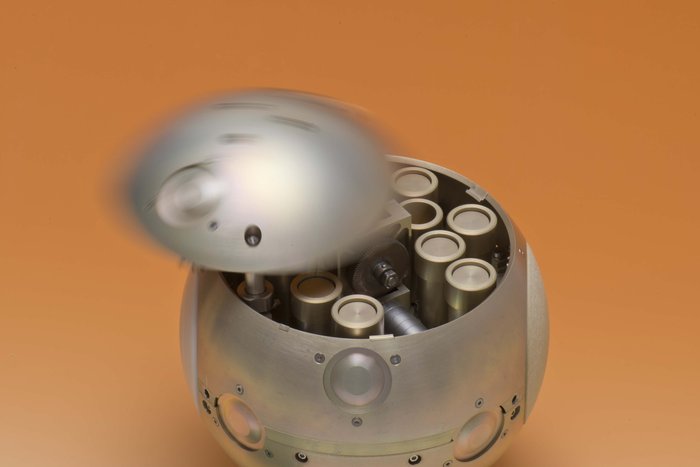Mars on Earth: Bringing Red Planet Samples Back Is a Considerable Challenge
How can we bring a sample of Mars safely back to Earth? With scientists worldwide curious about the Red Planet's potential for life, NASA and the European Space Agency are working on a future "sample-return" mission to safely study Mars materials.
One possible location for sample hunting could be a Martian spot called Jezero Crater, the site of an ancient lake — and possibly, also a location for ancient microbes.
While rovers and landers can study Mars when they land there, the challenge is that there is only so much space available on these machines for instruments. On Earth, entire laboratories could study Red Planet regolith (soil) and rocks. But getting the samples back to our planet will be a considerable engineering challenge.
Related: Mars Sample Return: Scientists Debate How to Bring Red Planet Rocks to Earth
ESA officials said in a statement that the two agencies plan to perform three launches from Earth and one from Mars as part of the mission, which will include two Mars rovers and an autonomous docking in Martian orbit.
“A NASA launch will send the sample return lander mission to land a platform near the Mars 2020 site. From here, a small ESA rover — the Sample Fetch Rover — will head out to retrieve the cached samples,” ESA officials said in another statement.
"Once it has collected them in what can be likened to an interplanetary treasure hunt, it will return to the lander platform and load them into a single large canister on the Mars Ascent Vehicle. This vehicle will perform the first liftoff from Mars and carry the container into Mars orbit. ESA’s Earth Return Orbiter will be the next mission, timed to capture the basketball-size sample container orbiting Mars … the spacecraft will then return to Earth, where it will release the entry capsule for the samples to end up in a specialized handling facility."
Breaking space news, the latest updates on rocket launches, skywatching events and more!
Once the samples arrive on Earth, they will go into quarantine — in a manner similar to how the Apollo 11, 12 and 14 astronauts were isolated after their moon missions about 50 years ago. Scientists are revising the planetary-protection guidelines in anticipation of this Martian milestone, ESA officials said.
"Quarantine will be inside a sample receiving facility, where the samples will already offer a treasure trove of information for scientists even before they are opened. Any Martian dust that might cover the outside of the sample tubes can be analyzed, and non-invasive techniques such as x-ray investigations can be run, even on unopened tubes," ESA officials said. "After the samples tubes are opened, a predetermined set of initial measurements will generate a detailed catalog of information, which will allow specialized science investigations to target specific parts of the samples."
Once it's time to open the samples, scientists must carefully consider the timing. Any Martian atmosphere trapped in the tubes may mix with Earth's as soon as they are opened, which would change the natural Red Planet chemical signatures.
Some experiments need to destroy sample material, ESA officials said. Even sterilization through heat, radiation or chemical processes has issues: While this is important to ensure Earthling safety, the process could change some samples from their state on the Red Planet.
ESA plans to hold a Space19+ council, a high-level government meeting, in November to determine its interest and participation in a future Mars sample-return mission, which would also include participation from NASA.
"Mars sample return would be a huge advancement for Mars science and the exploration of the solar system," Sanjay Vijendran, ESA's Mars sample-return campaign coordinator, said in a statement. "The samples will fundamentally advance our understanding of Mars, the history of our solar system, and will help us plan for future exploration missions."
- NASA Is Finally Funding a Mars Sample Return Mission, But Details Are Slim
- NASA Unlikely to Return Mars Samples in the 2020s
- NASA Proposes Rapid Mars Sample Return Architecture
Follow Elizabeth Howell on Twitter @howellspace. Follow us on Twitter @Spacedotcom and on Facebook.

Elizabeth Howell (she/her), Ph.D., was a staff writer in the spaceflight channel between 2022 and 2024 specializing in Canadian space news. She was contributing writer for Space.com for 10 years from 2012 to 2024. Elizabeth's reporting includes multiple exclusives with the White House, leading world coverage about a lost-and-found space tomato on the International Space Station, witnessing five human spaceflight launches on two continents, flying parabolic, working inside a spacesuit, and participating in a simulated Mars mission. Her latest book, "Why Am I Taller?" (ECW Press, 2022) is co-written with astronaut Dave Williams.

